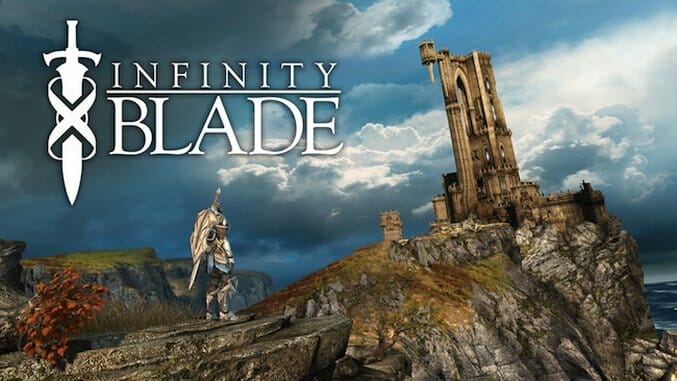Infinity Blade (iOS)

Aah, videogames. As you play them you will fight, you will emerge victorious, you will fight again, and eventually you will be defeated and you will die. And then somehow, you will rise to fight again. Your avatar will level up and become more powerful, and you yourself will become more proficient. This is the Way Of The Game, a cycle that is commonly referred to as a gameplay loop. Play, fail, die, and then try, try again.
Over time, the strange notion of impermanent death has become something that gamers have come to accept as a simple fact of life. Emergency! Peril! The princess is in danger! Only you can save her! (Oh also you are probably going to die a couple hundred times along the way. Trust me though you’ll be fine.)
It’s to the point that these days, that sort of sort of peculiar game-logic has become a part of our broader cultural vernacular. Almost everyone with a pulse is familiar with the concept of an “extra life”—in the recent film Scott Pilgrim vs. The World, the eponymous protagonist dies in his final battle, only to use a 1-Up in order to snag one last chance at redemption. I doubt there were very many people in the audience who questioned the logic of that development, or who didn’t get the joke. (Actually, I doubt there were many people in the audience at all, but that’s a topic for another article.)
As people have grown accustomed to that kind of videogame trope, creative developers have begin subverting audience expectations about what a gameplay loop should involve. Many recent games have worked death and defeat into their core design far more organically than the “Would you like to continue?” screen of old.
Japanese developer Atlus’ masterful 2009 dungeon-crawler Demon’s Souls flat-out expected players to die over and over again, resurrecting them as spirits after each death until they were finally able to defeat one of the game’s beastly bosses. Team Meat’s laughably difficult (and supremely fantastic) 2-D platformer Super Meat Boy wrung big yucks out of its insane difficulty, cheekily tracking a player’s thousands of deaths and presenting the final number as a badge of masochistic honor. And on the other side of the equation, experimental indie games like Jason Rohrer’s Sleep is Death and Marcus Richert’s You Only Live Once take the opposite tack, closing the loop and ending the game after a single death.
Chair’s new iOS action-RPG Infinity Blade embraces death and resurrection as well, weaving the circle of game-life into its narrative in a most brutally efficient manner. The story, such as it is, begins as these things so often do: in a cavernous, foreboding throne room. Almost immediately after players are given control, their nameless avatar is struck down by an unstoppable badass warrior-king. As tutorials go, it’s as brief as it is humbling.
Cut immediately to many years later, as players are given control of a new knight standing outside the castle’s walls. It turns out that this warrior is the first hero’s son, and we are to guide him on his quest to avenge his father. And so we fight our way through the castle’s battlements, up its tower, all the way to that same foreboding, cavernous throne room… before again getting stabbed to death by the still very high-level, entirely badass warrior king.
At which point the game cuts to many years later. Players are given control of the first hero’s son’s son, this time with their previously-earned stats, level and gear intact. They then must fight through the castle for a second time, facing off against higher-level, faster opponents. And of course, they eventually reach the foreboding, cavernous throne room, fight against the still-badass warrior king, and… okay, you can probably see where this is going. Stabbed, reborn as great-grandson and lo, the cycle continues. Et cetera, et cetera, amen.
-

-

-

-

-

-

-

-

-

-

-

-

-

-

-

-

-

-

-

-

-

-

-

-

-

-

-

-

-

-

-

-

-

-

-

-

-

-

-

-









































